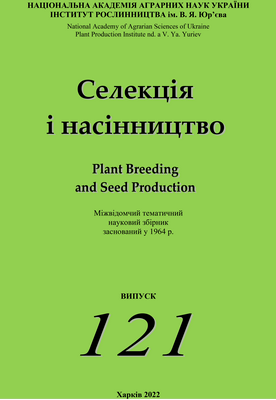Influence of seed heterogeneity on sowing and yielding parameters of rice cultivars
DOI:
https://doi.org/10.30835/2413-7510.2022.260988Ключевые слова:
rice, 1000-seed weight, germination energy, field germinability, yield, heterogeneityАннотация
Purpose and objectives. The cultivation technology development was aimed at maximizing the potential productivity of the crop. To accomplish this, studies of heterogeneity are not only of theoretical but also of practical value, as knowledge of this phenomenon can open new opportunities to improve seed quality.
Materials and methods. In 2019–2020, the field and laboratory experiments were carried out in the rice crop rotation of the Institute of Rice of NAAS. The farming technique of the experiment met the requirements for experimentation, as Dospekhov B.A. described.
Results and discussion. This article covers the results on the performance patterns of new rice cultivars and their seed parameters, depending on the matrical heterogeneity. The yield in the field experiments across the study years ranged 8.05 to 11.68 t/ha, depending on a combination of the factors under investigation. It was found that the rice produced high yields in the plots sown with seeds from the upper part of the panicle, regardless of the cultivar. In the plots sown with seeds from the lower part of the panicle, there was a shortfall of planting material from 1.85 to 2.30 t/ha in comparison with the plots sown with seeds from the upper part of the panicle. Therefore, sowing seeds from the lower part of the panicle means irrational use of planting material, resulting in thinned crops and decreased yields, which in turn leads to the production of low-quality seeds.
Conclusions. Thus, the matrical heterogeneity-based selection of rice seeds from the upper part of the panicle in the primary stages of seed production is an important technological approach. This contributes to an increase in the yield and quality of rice seeds, allowing for accelerated implementation of new rice cultivars into production.
Библиографические ссылки
Bardysheva GM, Yemelyanova NA. Rice and its quality. Moscow: Kolos, 1976. 400 p.
Vorobyev NV. The physiology of germination of rice seed. [dissertation]. Moscow, 1983.
Izhik NK. Germination of seeds. Kyiv: Urozhay, 1979. 199 p.
Kizilova YeG. Variability of seeds and its agronomic value. Kyiv: Urozhay, 1974. 216 p.
Makrushyn MM, Makrushyna YeM. Seed production. Heterospermia and its usage in selection and seed production. Simferopol: Arial, 2012. P. 82–95.
Makrushyn MM, Makrushyna YeM. The most important principles of prediction of biological properties and the selection of seeds. The scientific research of the filial branch of the National University of biological resource and nature management of Ukraine. 2009; 127: 11–15.
Vlaschuk FM, Drobit OS, Pryshchepo MM, Konashchuk OP.Scientific bases system of seed grower of the south of Ukraine. Kherson, 2019. P. 64–68. doi.org/10.32848/0135-2369.2019.72.15.
DSTU 4138-2002. (2003) The seeds of agricultural crops. Quality determination methods. Kyiv: Derzhstandart Ukraine. 173 p.
Загрузки
Опубликован
Выпуск
Раздел
Лицензия
Copyright (c) 2022 O. S. Dovbush, D. V. Shpak, T. M. Shpak, H. V. Melnichenko

Это произведение доступно по лицензии Creative Commons «Attribution» («Атрибуция») 4.0 Всемирная.
При размещении текстов статей в электронных ресурсах авторские права сохраняются за автором печатной публикации.
Автор может не соглашаться с правками рецензентов и редакции, мотивируя при этом свою точку зрения.
Автор может требовать от редакции разъяснений или изменений в случае обнаружения существенных ошибок в его статье.
Автор может использовать материалы, опубликованные в журнале «Селекция и семеноводство» в своих работах, обязательно ссылаясь на наш журнал.

